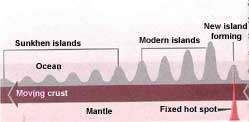Gaea s youngest
 a jet of molten lava arises from the womb of the earth, pierces through the seabed and gives rise to islands amidst a turbulent ocean. In a rare feat of scientific endeavour, the birth throes of an emerging island in the ocean were witnessed for the first time by scientists recently. Loihi, the young, undersea volcano 30 km south-east of the main island of Hawaii, has suddenly become one of the world's most active volcanoes.
a jet of molten lava arises from the womb of the earth, pierces through the seabed and gives rise to islands amidst a turbulent ocean. In a rare feat of scientific endeavour, the birth throes of an emerging island in the ocean were witnessed for the first time by scientists recently. Loihi, the young, undersea volcano 30 km south-east of the main island of Hawaii, has suddenly become one of the world's most active volcanoes.
Riding a submersible, a team of explorers under Alexander Malahoff of the Hawaii Undersea Research Laboratory at the University of Hawaii, dived into the dark churning waters of the ocean. The aim was to probe the cause of thousands of earthquakes that shook the area in the past months. The research ship carrying Malahoff and his colleagues dove to the recesses of the undersea volcano and discovered that so much debris had been thrown out by the eruption that they could hardly see more than a metre ahead.
But the most striking discovery was that the turmoil at the volcano's top had collapsed its summit, creating a crater more than half-a-mile-wide and 1,000 feet-deep. Pete's dome, an area on the southern rim of the volcano that previously had been considered very stable, had simply vanished. Scientists discovered a riot of landslides, toppled rock formations and bus-size volcanic boulders strewn around. The collapsed crater had vents spewing a mixture of superheated water, dissolved minerals and microbes that thrive in the seabed's rocky substrate.
"The tumult is part of the volcano's upward growth,' say scientists. Lava-flows build it up and avalanches and cataclysmic explosions knock it down. This widens the crater, creating a larger base for the next stage of building. "The fight is between construction and destruction,' says Malahoff. The team estimates that the collapse of the summit took two to three days and the slow collapse prevented generation of a huge tsunami, or tidal wave, that could have caused largescale destruction in the adjoining islands.
The process by which islands are formed in this zone due to volcanic upheaval is dynamic. The great heat engine within the earth stirs a sea of hot plastic rock that melts through the crust in places. A vast majority of this action takes place in the hidden darkness of the deep sea. In certain places, the interior heat gives rise to jets or plumes of lava that are stationary in relation to tectonic plates that move slowly overhead. The gigantic plates that make up the earth's crust move at the rate of a few centimetres a year, or about as fast as fingernails grow. As a result of this slow movement, a single jet can, over the ages, leave a trail of extinct volcanoes in the plate tens of thousands of years before Loihi's fiery summit rises above the waves.
